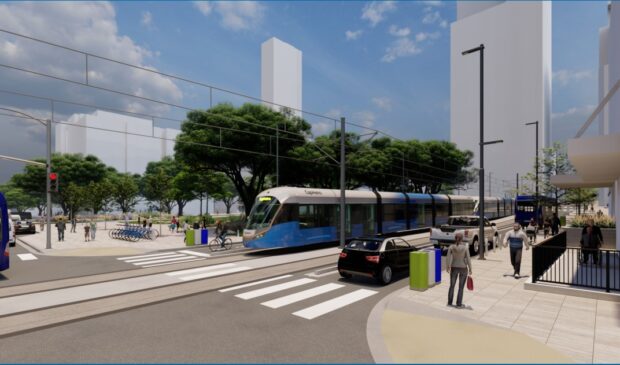Photo by Austin Transit Partnership. Conceptual rendering of Guadalupe Street at Republic Square.
Housing and Planning Committee weighs in on light rail design plans, preparing for challenging decisions
Tuesday, May 2, 2023 by
Kali Bramble With the June deadline for a final proposal fast approaching, Austin’s long-awaited light rail system is beginning to take shape.
Austin Transit Partnership, Capital Metropolitan Transportation Authority and city staff all joined City Council’s Housing and Planning Committee last week to discuss the five designs for the first phase of the multibillion-dollar infrastructure project, each prioritizing different service areas north and southeast of downtown.
“We’re essentially retrofitting major transit infrastructure for the 11th largest city in the nation, and that is not an easy task,” said Council Member Natasha Harper-Madison, who chairs the committee.
Since 2020, Project Connect’s $7.1 billion price tag has inflated to nearly $11.6 billion as estimated land acquisition and construction costs keep climbing. Forced to scale back some of its more ambitious plans, the project’s team is prepared to move forward with an initial “core system” running from at least the University of Texas campus through downtown via Guadalupe Street, before crossing the river to continue down East Riverside Drive to Pleasant Valley.
From there, the five plans deviate, with one extending to the North Lamar Boulevard transit center, one extending east to the airport, and two prioritizing smaller extensions down South Congress Avenue to Oltorf Street. The most compact option, extending from the UT campus to a parking station near State Highway 71 and U.S. Highway 183, could involve burying the rail line and stations between 20th and Eighth streets.
Looming large is the question of maintenance planning, with two viable maintenance facility sites at the North Lamar Transit Center and the airport commerce center near SH 71 and U.S. 183 presenting a number of logistical challenges to the system’s terminal options. While the four designs placing the facility near its east terminal will require some coordination with the Texas Department of Transportation to extend to the airport, the option ending at the North Lamar Transit Center depends entirely on TxDOT’s approval of a bridge project to cross the Red Line at U.S. 183.
With all of this riding on the team’s next moves, Harper-Madison urged staff not to give up on the trickier northward and eastern extensions just yet.
“I’ve got to tell you, North Lamar and 183, those spaces you talked about in the 71 interface, those are not coming up at my (Capital Area Metropolitan Planning Organization) meetings. I’m a little concerned that it’s not on the appropriate people’s radar,” said Harper-Madison. “I’d like for y’all to take advantage of the fact that there are members of this body on various transportation bodies, statewide and regionally. Let us know what we need to be bringing as future items for consideration.”
The decision will also impact forthcoming affordable housing projects, with $300 million in funding on the table for land acquisition and development assistance programs within a mile of planned rail lines over the next 12 years. As of now, only the North Lamar Transit Center design would unlock these development opportunities farther north than 38th Street, with the rest prioritizing Central Austin and East Riverside Drive.
The Project Connect team is taking public comment on the five designs for one more day, with plans to review and make its final selection sometime next month. In the meantime, Harper-Madison said she hopes it will consider the impact on working-class populations that need public transportation the most.
“We have 365,000 workers in our hospitality industry in this city. Where do the people working at the Hilton, and at the W, where do they live? You don’t wanna know,” said Harper-Madison. “They’re out here riding with no inspection because they have to …. They just spent their whole income tax return on a car because they had to. All of these things have a direct impact on people’s lives.”
The Austin Monitor’s work is made possible by donations from the community. Though our reporting covers donors from time to time, we are careful to keep business and editorial efforts separate while maintaining transparency. A complete list of donors is available here, and our code of ethics is explained here.
You're a community leader
And we’re honored you look to us for serious, in-depth news. You know a strong community needs local and dedicated watchdog reporting. We’re here for you and that won’t change. Now will you take the powerful next step and support our nonprofit news organization?






